Boiling point 204 °C Melting point -43.53 °C Molar mass 86.0891 g/mol Appearance Colorless liquid | Formula C4H6O2 Density 1.13 g/cm³ IUPAC ID Dihydrofuran-2(3H)-one | |
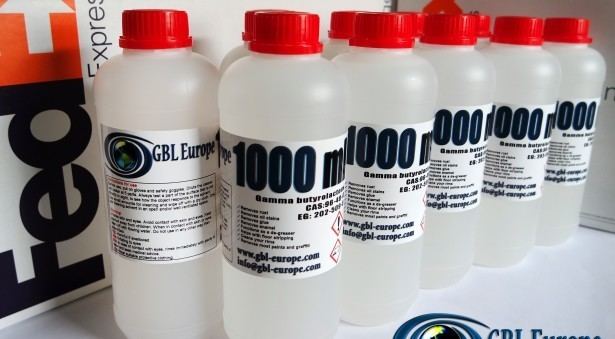 | ||
Gamma butyrolactone
γ-Butyrolactone (GBL) is a hygroscopic colorless liquid with a weak characteristic odor. Soluble in water, GBL is a common solvent and reagent in chemistry as well as being used as a flavouring, as a cleaning solvent, as a superglue remover, and as a solvent in some wet aluminium electrolytic capacitors. In humans it acts as a prodrug for γ-hydroxybutyric acid (GHB), and it is used as a recreational intoxicant with effects similar to alcohol.
Contents
- Gamma butyrolactone
- Occurrence
- Preparation
- Reactions
- Polymerization
- Pharmacology
- Pharmacokinetics
- Nutritional supplement
- Recreational drug
- Dangers
- Addictiveness
- Dose
- Legal status
- References
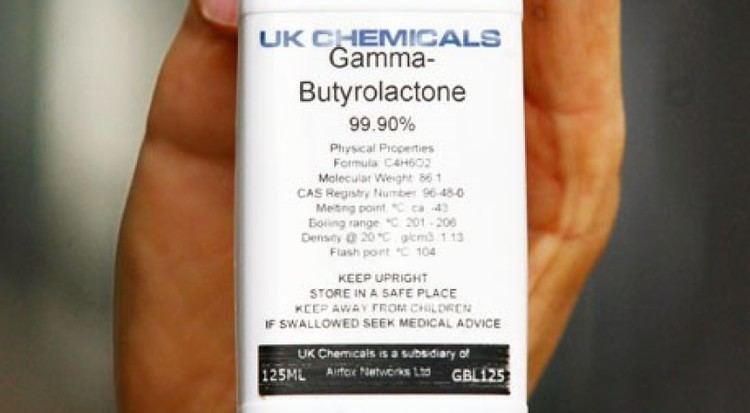
Occurrence
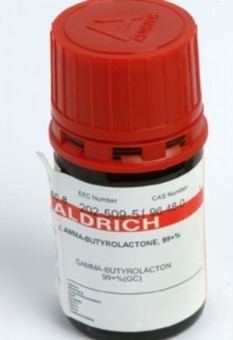
GBL has been found in extracts from samples of unadulterated wines. This finding indicates that GBL is a naturally occurring component in some wines and may be present in similar products. The concentration detected was approximately 5 μg/mL and was easily observed using a simple extraction technique followed by GC/MS analysis. GBL can be found in cheese flavourings but typically results in a content of 0.0002% GBL in the final foodstuff.
Preparation
GBL is produced industrially by dehydrogenation of 1,4-butanediol. This route proceeds via dehydration of GHB.
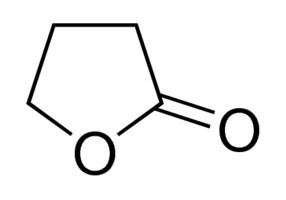
In the laboratory, it may also be obtained via the oxidation of tetrahydrofuran (THF), for example with aqueous sodium bromate.
Reactions

As a lactone, GBL is hydrolyzed under basic conditions, for example in a sodium hydroxide solution into sodium gamma-hydroxybutyrate, the sodium salt of gamma-hydroxybutyric acid. In acidic water, a mixture of the lactone and acid forms coexist in an equilibrium. These compounds then may go on to form the polymer poly(4-hydroxybutyrate). When treated with a non-nucleophilic base, such as lithium diisopropylamide, GBL undergoes deprotonation alpha to the carbonyl. The related compound caprolactone can be used to make a polyester in this manner.
Polymerization
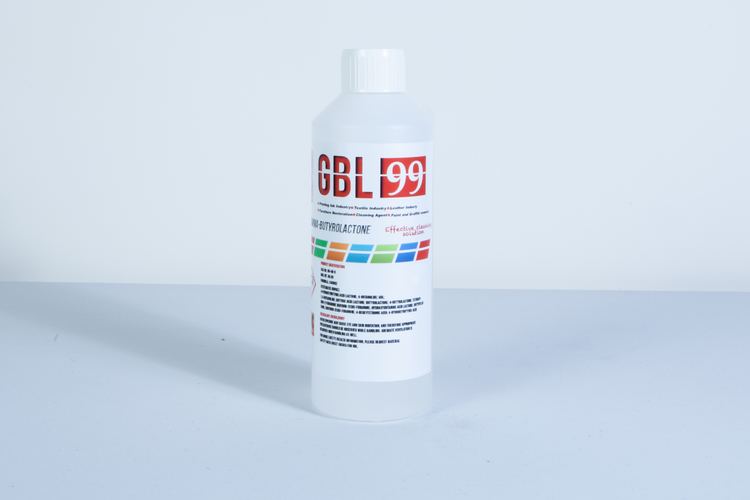
A variety of catalysts promote the ring-opening polymerization of butyrolactone, poly(GBL). The resulting polybutyrolactone reverts to the monomer by thermal cracking. It is claimed that poly(GBL) is competitive with commercial biomaterial poly(4-hydroxybutyrate), or P4HB. It is further claimed that poly(GBL) is cheaper to make than P4HB, although both are bio-derived.
Pharmacology
GBL is not active in its own right; its mechanism of action stems from its identity as a prodrug of GHB.
The hypnotic effect of GHB is enhanced by combination with alcohol. A 2003 rat study showed that GBL in combination with ethanol showed a potentiated hypnotic effect, as the sleep-timing measure was longer than both of the individual components combined.
Pharmacokinetics
GBL is rapidly converted into GHB by paraoxonase (lactonase) enzymes, found in the blood. Animals which lack these enzymes exhibit no effect from GBL. GBL is more lipophilic (fat soluble) than GHB, and so is absorbed faster and has higher bioavailability. Because of these pharmacokinetic differences, GBL tends to be more potent and faster-acting than GHB, but has a shorter duration; whereas the related compound 1,4-butanediol (1,4-B) tends to be slightly less potent, slower to take effect but longer-acting than GHB.
The levels of lactonase enzyme can vary between individuals, meaning that first-time users can show unpredictable results, even from small doses. In many this manifests as slow onset of effects, followed by headaches, semi-consciousness which is distinct from GBL sleep in normal users. If the user decides to try again at a later date, they appear to be able to enjoy the effects normally.
Nutritional supplement
Due to its property of being a prodrug of GHB which increases sleep related growth hormone (GH) secretion, GBL was sold as a nutritional supplement after the scheduling of GHB, under the names Revivarant and Renewtrient in the U.S. at least until the end of 1999.
Recreational drug
GBL is a prodrug of GHB and its recreational use comes entirely as a result of this. To bypass GHB restriction laws, home synthesis kits were introduced to transform GBL and/or 1,4-B into GHB.
GBL overdose can cause irrational behaviour, severe sickness, coma and death. GBL has a distinctive taste and odour, described as being comparable to stale water, synthetic melon aroma or burnt plastic. This differs significantly from GHB, which is described as having a decidedly "salty" taste.
Dangers
If taken undiluted by mouth, GBL can cause esophageal and gastro-intestinal irritation. It is possible for oral ingestion of GBL to cause nausea and other similar problems, possibly more so than with GHB.
GHB has biphasic effects, a euphoric effect at low doses (the reason for the term liquid ecstasy), and a sedative effect at higher doses. As a result of this sedation it can cause unconsciousness. When combined with alcohol the increased sedation and risk of vomiting results in a high risk of fatality. Many harm reduction organisations suggest never mixing the two drugs as a result.
There have been news reports of several deaths associated with GBL, usually in combination with alcohol or other depressants.
Addictiveness
Frequent use of GHB/GBL, even when taken long-term and in moderate doses, does not appear to cause significant physical dependency in the majority of its users. In many people, quitting or temporarily abstaining from use of the drugs is achieved with minimal or no difficulty. However, when consumed in excessive amounts with a high frequency of dosing, physical and psychological dependence can develop.
There are some reports of GHB/GBL users adopting a '24/7' dosing regime. This is where the user has become tolerant to the effects of the drug, increasing the dosage and frequency of dosage simply to avoid withdrawal symptoms.
For those users who do report withdrawal symptoms upon quitting the use of GHB/GBL, symptoms seem to depend on the dosage and the length of time the drug was used. Light to moderate users often experience insomnia and sleep-related problems, whereas heavy, prolonged use can cause severe withdrawal symptoms similar to Benzodiazepine withdrawal syndrome (BWS).
Dose
A milliliter of pure GBL metabolizes to the equivalent 1.65g of NaGHB, the common form, so doses are measured in the single milliliter range, either taken all at once or sipped over the course of a night.
Legal status
Australia: GBL is not classified as a drug but as a health-endangering substance. Although recently passed legislation to enter into force on 1 April 2011 will make it possible to handle narcotics for industrial purposes will enable GBL and 1,4-Butanediol to be classified as controlled substances.
Canada: GBL is a Controlled Substance under Schedule VI of the "Controlled Drugs and Substances Act" in Canada. Schedule VI of the "Controlled Drugs and Substances Act" requires vendors to collect information regarding purchases of GBL. The Act also prohibits the import and export of GBL into or out of Canada classifying it as either an indictable offense punishable with up to 10 years in prison or an offense punishable on summary conviction liable to imprisonment for up to eighteen months. It is not illegal for an individual to possess GBL in Canada.
Germany: GBL is not listed in the narcotics law, but its distribution is controlled. Possession is not illegal, but may be punished according to the Medicines Act, when intended to be sold for human consumption or synthesis of GHB. In recent years, an increase of GBL consumption has been observed due to the prohibition of GHB.
Hong Kong SAR: GBL is a dangerous drug controlled under Schedule 1 of the Dangerous Drugs Ordinance, Cap.134 (with exemption clause at Paragraph 16D). Any person who is found to have in his possession of it not in accordance with this Ordinance can be liable, on conviction upon indictment, a fine of HK$1,000,000 and to imprisonment for 7 years.
Israel: GBL was classified as a proscribed substance from 2007.
The Netherlands: GBL has been placed on list 1 of the "Opiumwet" (literally translated: "Opiumlaw"). Therefore, export and import, possession, manufacturing, sale and transport are forbidden. However, use of drugs forbidden by the Opiumwet is not considered illegal, but mainly treated as a public health concern.
Poland: GBL is not classified as a drug and can be purchased in chemistry shops as a solvent.
Russia: GBL is classified as psychotropic substance since 22 February 2012, its trafficking is limited, and non-licensed selling, buying or any other using is imprisoned up to 20 years.
Sweden: GBL is not classified as a drug but as a health-endangering substance. Although recently passed legislation to enter into force on 1 April 2011 will make it possible to handle narcotics for industrial purposes will enable GBL and 1,4-Butanediol to be classified as controlled substances.
United Kingdom: Because of their legitimate uses, regulation 4B of the 2001 regulations makes it lawful to import, export, produce, supply, offer to supply or possess GBL and 1,4-BD. Except where a person does so knowing or believing that they will be used for the purpose of human ingestion.
United States: GBL is regulated as a List I controlled chemical. As a GHB analog, it is also treated as a controlled substance under Schedule I of the Controlled Substances Act if intended for human consumption.
